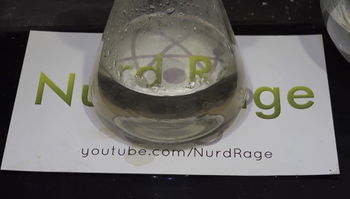Hydrobromic acid
Hydrobromic acid is a solution of hydrogen bromide in water. It is normally a clear, colorless liquid, sometimes colored yellowish or brown by decomposition (oxidation by air) and release of elemental bromine, with a strong odor. It is one of the strongest mineral acids.
Contents
Properties
Physical properties
The physical properties of hydrobromic acid vary depending on its concentration. Azeotropic hydrobromic acid contains 48% HBr, has a density of 1.49 g/cm3, and boils at 12 4°C. Over-azeotropic solutions of this acid fume.
Chemical properties
Hydrobromic acid is a strong acid, with properties similar to hydrochloric acid. It's, however, a somewhat stronger reducing agent.
The main property of this acid and the reason why it's sought after is its ability to brominate compounds. It is used to obtain both inorganic and organic bromides.
Sources
Chemical reagent stores typically supply hydrobromic acid. It is not usually used in any household chemicals, though one Sciencemadness user reported that he found hydrobromic acid as a drain cleaner of unspecified brand.
Preparation and purification
The main way of synthesizing hydrobromic acid is the reaction between alkali metal bromides and diluted sulfuric acid, usually at a concentration of around 5.8 M.
- H2SO4 + KBr → KHSO4 + HBr
Sodium bisulfate can also be used instead.[1]
Care must be taken not to use concentrated sulfuric acid or another oxidizing acid, because these acids oxidize bromide to elemental bromine. Likewise, the reaction temperature must not exceed 75 °C, as this will further oxidize HBr to elemental bromine. Even so, the resulting acid may come out brown, contaminated with a small amount of bromine. The bromine contamination can be removed by refluxing the acid with red phosphorus or elemental sulfur. Sodium metabisulfite can also be used, and it's a better alternative.[2]
Hydrobromic acid can be easily prepared in the laboratory via the reaction of elemental bromine, sulfur dioxide, and water.[3]
- Br2 + SO2 + 2 H2O → H2SO4 + 2 HBr
Elemental bromine needed for this reaction can be produced by addition of oxone to a bromide salt, like sodium bromide.
Anhydrous HBr can be purified by letting the gas through a solution of phenol in tetrachloromethane. Azeotropic hydrobromic acid cannot be purified this way. However, azeotropic HBr can be re-distilled, which typically removes the yellow or brown color and gives clear, colorless acid.
Projects
- Make sulfuric acid from sulfur, using NurdRage's electrobromine process (the hydrobromic acid is not expended in this process and is fully regenerated);
- Make elemental bromine;
- Make brominated hydrocarbons from alcohols (useful in making grignards)
Handling
Safety
Hydrobromic acid is a strong and corrosive acid. Protective clothing and gear is recommended when handling it. Concentrated solutions fume with hydrogen bromide gas, which is an irritant to lungs.
The toxicity of hydrobromic acid is relatively low. Bromide poisoning is possible, but requires large doses of bromides taken by the organism.
Storage
Hydrobromic acid should be stored the same way as any other strong fuming acid: in a glass bottle, locked in a special acid cabinet.
Disposal
Hydrobromic acid should be neutralized before disposal. Any non-toxic base will do the trick.
References
- ↑ https://www.youtube.com/watch?v=C3n4Xqfb9qk
- ↑ https://www.youtube.com/watch?v=4ei_xUIhRas
- ↑ Scott, A. (1900). "Preparation of Pure Hydrobromic Acid". Journal of the Chemical Society, Transactions. 77: 648–651
